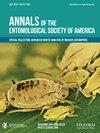Cyclic Depsipeptides and Linear Peptides With Cytotoxic and Antiphytopathogenic Activities From Symbiotic Bacteria of Xenorhabdus (Enterobacteriales: Morganellaceae) Genus
IF 1.8
3区 农林科学
Q1 ENTOMOLOGY
引用次数: 0
Abstract
Abstract On the basis of biological activities of the ethyl acetate extracts of four Xenorhabdus sp., including Xenorhabdus nematophila FUM 220, Xenorhabdus nematophila FUM 221, Xenorhabdus bovienii FUM 222, and Xenorhabdus bovienii FUM 223, X. nematophila FUM 220 was preferentially selected to track the isolation of responsible compounds. Chemical study on the ethyl acetate extract of X. nematophila isolate FUM220 which is derived from the native nematode Steinernema carpocapsae (Rhabditida: Steinernematidae), was evaluated, and eleven compounds, including xenocoumacin II (1), xenortide-396 (2), xenortide A (3), xenortide-410 (4), xenortide-449 (5), xenematide A 663 (6), rhabdopeptide-574 (7), rhabdopeptide-588 (8), rhabdopeptide-687 (9), rhabdopeptide-701 (10), and nematophin-273 (11) were characterized. In this experimental study, we surveyed the antitumoral potential of bacterial extract and bacterial metabolites to treat human breast cancer (MCF-7), human lung cancer (A549), and murineTumor (B16) cell lines. We observed that all samples were cytotoxic, but bacterial extracts of X. nematophila FUM 220 and X. bovienii FUM 223 showed higher toxicity on mentioned cell lines. Potent cytotoxic activity was found for compounds 6 and 11 with IC50 of 6.2 µg/ml against human lung cancer A549 cell lines, too.These compounds showed moderated antibacterial activity against Xanthomonas oryzae pv. oryzae strain Xoo-IR42 (Xanthomonadales: Xanthomonadaceae) (MIC of 62.5 µg/ml) and Staphylococcus aureus strain 1112 (Bacillales: Staphylococcaceae) (MIC of 100 µg/ ml). The bacterial extracts from X. bovienii FUM 222 showed strong inhibition of the growth of S. aureus strain 1112, by a minimal inhibitory concentration assay (MIC of 53.5 µg/ml). Xenorhabdus genera produce metabolites with potent cytotoxic and antibacterial activity. Single compounds can be isolated, identified, and commercialized, but various species or strains may change their anticancer or antimicrobial potential. The present study brings new clues regarding the qualified of Xenorhabdus as future peptide sources for supplying natural bioactive compounds and challenge multidrug-resistant bacteria, treat cancer, and plant diseases. Graphical Abstract具有细胞毒性和抗植物病原体活性的环沉积肽和线状肽
摘要根据嗜线虫Xenorhabdus nematophila FUM 220、嗜线虫Xenorhabdus nematophila FUM 221、牛线虫Xenorhabdus bovienii FUM 222、牛线虫Xenorhabdus bovienii FUM 223四种Xenorhabdus sp.乙酸乙酯提取物的生物活性,优选嗜线虫Xenorhabdus FUM 220进行目标化合物的追踪分离。对从天然线虫Steinernema carpocapsae (Rhabditida: Steinernematidae)中提取的嗜线虫X. nematophila分离物FUM220的乙酸乙酯提取物进行了化学研究,鉴定了11个化合物,包括xenocoumacin II(1)、xenortide-396(2)、xenortide- A(3)、xenortide-410(4)、xenortide-449(5)、xenematide A 663(6)、rhabdopeptide-574(7)、rhabdopeptide-588(8)、rhabdopeptide-687(9)、rhabdopeptide-701(10)和nematophin-273(11)。在这项实验研究中,我们调查了细菌提取物和细菌代谢物对人乳腺癌(MCF-7)、人肺癌(A549)和小鼠肿瘤(B16)细胞系的抗肿瘤潜力。我们观察到所有样品都具有细胞毒性,但嗜线虫X. FUM 220和X. bovienii FUM 223的细菌提取物对上述细胞系的毒性更高。化合物6和11对人肺癌A549细胞株也有较强的细胞毒活性,IC50值为6.2µg/ml。这些化合物对米黄单胞菌具有较弱的抑菌活性。oryzae菌株xo - ir42 (Xanthomonadales: Xanthomonadaceae) (MIC为62.5µg/ml)和Staphylococcus aureus菌株1112 (Bacillales: Staphylococcaceae) (MIC为100µg/ml)。通过最小抑制浓度测定(MIC为53.5µg/ml), X. bovienii FUM 222细菌提取物对金黄色葡萄球菌菌株1112的生长有较强的抑制作用。Xenorhabdus属产生具有强细胞毒性和抗菌活性的代谢物。单一化合物可以分离、鉴定和商业化,但不同的物种或菌株可能会改变其抗癌或抗菌潜力。本研究为Xenorhabdus作为天然生物活性化合物的来源、对抗多药耐药菌、治疗癌症和植物病害提供了新的线索。图形抽象
本文章由计算机程序翻译,如有差异,请以英文原文为准。
求助全文
约1分钟内获得全文
求助全文
来源期刊
CiteScore
4.90
自引率
0.00%
发文量
25
审稿时长
6-12 weeks
期刊介绍:
The Annals of the Entomological Society of America exists to stimulate interdisciplinary dialogue across the entomological disciplines and to advance cooperative interaction among diverse groups of entomologists. It seeks to attract and publish cutting-edge research, reviews, collections of articles on a common topic of broad interest, and discussion of topics with national or international importance. We especially welcome articles covering developing areas of research, controversial issues or debate, and topics of importance to society. Manuscripts that are primarily reports of new species, methodology, pest management, or the biology of single species generally will be referred to other journals of the ESA. The most important criteria for acceptance are quality of work and breadth of interest to the readership.

 求助内容:
求助内容: 应助结果提醒方式:
应助结果提醒方式:


